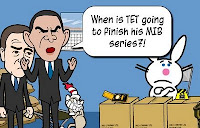GoAnimate has been beta testing a new feature that allows you to add video objects to your animation. More about that in a moment. Just prior to the video feature's release to GoAnimate beta testers I made an animation called 'Moonlighting - TET's New PA'.
 The premise being Jim Benton's Happy Bunny, from my GoAnimate Complaints Department, series decides to take a job moonlighting as my personal assistant. The idea came about as I way to humorously inform my fans of the status on some of my on going series projects like MIB and Harry Chalk as well humorously look at some of the problems of being a popular GoAnimator.
The premise being Jim Benton's Happy Bunny, from my GoAnimate Complaints Department, series decides to take a job moonlighting as my personal assistant. The idea came about as I way to humorously inform my fans of the status on some of my on going series projects like MIB and Harry Chalk as well humorously look at some of the problems of being a popular GoAnimator.Moonlighting - TET's New PA by etourist
Like it? Create your own at GoAnimate.com. It's free and fun!
There's not much more that needs to be said about the above animation. It's basically the GoAnimate Complaints Department in a new setting with a trap door.
I discovered GoAnimate's new video upload feature on GoAnimate's Forum in a discussion where someone had tried to unsuccessfully upload the Youtube meme, Charlie bit my finger. I decided to take quick action to be one of the first to demonstrate how video could enhance and have great potential for creativity within animation rather than be a means to which people could just upload video to GoAnimate and do nothing else with it.
TET's PA Video Test by etourist
Like it? Create your own at GoAnimate.com. It's free and fun!
Created as a kind of short continuation of my previously mentioned TET's PA animation I created this short video demonstration over the best part of an afternoon. Since Happy Bunny had used the trap door quite a bit I thought me questioning him about it's effectiveness seemed like a good idea.
Once I'd written my lines I set up my video camera in my studio (which is a two car garage) so that it pointed directly at a wall. Then I imagined where Happy Bunnies desk would be and then put myself in frame so it looked kind of like me sitting opposite the desk.
I then acted my lines, being careful to look about where I thought Happy Bunnies face would be (I didn't set up any markers I just imagined its position based on how I framed the shot). I think I filmed about five takes with the one I used being either take 4 or 5.
I also recorded myself reading Happy Bunnies lines out in my studio so his audio would sound like it was recorded in the same space (which it was - obviously)
After that I imported the raw footage in my video editing software to remove the lead in and lead out footage so that only the section I needed remained. Then I added in Happy Bunnies spoken audio in the appropriate gaps (complete with helium voice effect). Once done I compiled this scene into a windows media file and uploaded it to GoAnimate.
Once yoour video is on GoAnimate you can simply place it on the studio stage like any other object, character or prop. You can move it around, resize it and place it in front or behind objects. The video also retains it's sound track - effectively giving you an extra audio track on top of the four already provided in the studio.
In GoAnimates studio I positioned the video and then placed all the props around it and positioned Happy Bunny so his face matched where I was looking in the recorded footage. That was really all there was to it. After that it's just like editing any other animation.
I haven't seen many other beta testers try this feature out which is kind of surprising to me. I think there is a genuine concern that this feature will be misused and people will simply upload video and forget to enhance it in some way with animation. Which is perhaps one reason why it's not been used a lot.
However I think it is a great addition to GoAnimate's studio that does open up many creative possibilities in the right directors hands. I know I'll certainly be trying more with video on GoAnimate in the future.


Cool chroma keying here TET!
ReplyDeleteActually there was no Chroma keying involved in this animation. The live action video is an object like any other in GoA's studio. I just placed all the cartoon elements in front of it.
ReplyDelete